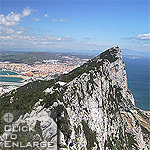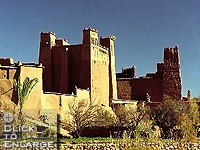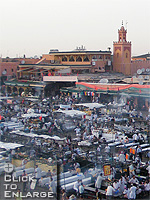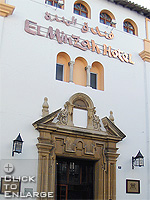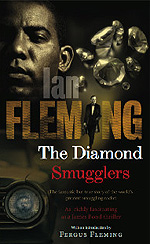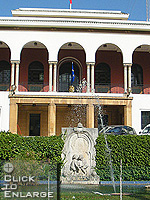Boats and Trains and Planes – and a Taxi
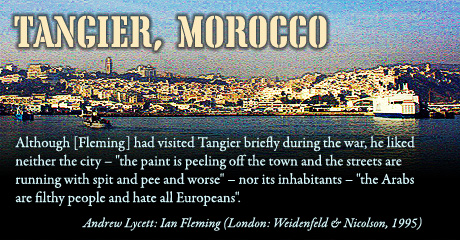
James Bond creator Ian Fleming has been criticized for the open racism and snobism in the above quote, but to be honest, on my first visit in Tangier twenty-two years ago, I initially found it to be not that far from how Fleming described it. Arriving at the port, one could see dozens of people waiting for the tourist ferries, and after disembarking, passengers found themselves harassed by hustlers who wanted to sell trinkets, carpets or kif (hashish), be their guide or just begging (more or less aggressively) for a Dirham (the local currency) or two. Despite looking great from the sea, the town didn’t make a very much inviting impression but more that of a faded grandeur, and until a few years ago, travelers were advised not to stay there for long if it can be avoided. I remember that two kilometer walk from the pier to the old train station as quite an ordeal, and we were happy to get out of town quickly, with only one from our backpackers group of five being ripped off in a dark alley, where he found himself getting “convinced” to buy an overpriced souvenir with a knife as an argument. And it certainly wasn’t better in the 1950’s when Fleming wrote this.
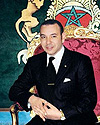
HM King Mohammed VI of Morocco
Today, all this has changed very much – for the better. They say the old King Hasan II didn’t like Tangier very much and neglected it. People were to look more or less after themselves, which is always a good breeding ground for hustlers, crime and dubious business. King Mohammad VI (enthroned in 1999), was well aware of the city’s bad reputation, and as Tangier still is a main gate to Morocco from Europe, he rightfully assumed that it would rub off on the rest of the country. He had the hustlers and con-men cleaned out and started a modernisation project coinciding with Tangier’s bid to host the 2012 International Exposition (for which the final vote went to Yeosu/South Korea). Today, Tangier is safe for tourists to visit as can be. Once all the new buildings are completed and some of the old ones received a new coat of paint, it will certainly become a popular traveling destination in Morocco – even though it will have lost a lot of it’s old magic by then.
 Just a few more words before I get to the point: I always wanted to return and pay Morocco a proper visit, as the first time was merely shooting in and out within three days. And as my Bond fandom was a bit on hiatus at that time, I didn’t care for visiting locations. My plan was a visit to a friend, who’s living in southern Spain, then by bus to Algeciras, by ferry to Tangier and by train down south to Marrakech, with a stopover (in honor of the Marx Brothers and not Humphrey Bogart) spending A Night in Casablanca. On my way back, a short visit (I scheduled half a day) to Tangier to see some of the locations from The Living Daylights. A cheap direct flight to Marrakech would have been possible, but I wanted a bit of a traveling adventure, a journey by boats, trains and planes.
Just a few more words before I get to the point: I always wanted to return and pay Morocco a proper visit, as the first time was merely shooting in and out within three days. And as my Bond fandom was a bit on hiatus at that time, I didn’t care for visiting locations. My plan was a visit to a friend, who’s living in southern Spain, then by bus to Algeciras, by ferry to Tangier and by train down south to Marrakech, with a stopover (in honor of the Marx Brothers and not Humphrey Bogart) spending A Night in Casablanca. On my way back, a short visit (I scheduled half a day) to Tangier to see some of the locations from The Living Daylights. A cheap direct flight to Marrakech would have been possible, but I wanted a bit of a traveling adventure, a journey by boats, trains and planes.
There are some opportunities in southern Spain to visit Bond locations. Cadiz, which doubled for Cuba in Die Another Day, and of course Gibraltar Rock from The Living Daylights‘ pre- title sequence. But with my limited timeframe – each of them would have cost me a day – I had to make the tough decision to skip them both. I would at least see Gibraltar from the ferry. I reckon that there also would have been some locations from Raymond Benson’s Doubleshot, but as I haven’t read that book (one reason for that being it’s unavailability in German), I decided not to delve deeper and to omit those, too.
With Marrakech being my final destination, I was also thinking about going to Ouarzazate and the Kasbah of Aït Benhaddou (where TLD’s Afghanistan scenes were shot) which is within relatively short distance. But this would have meant a four hour bus ride over Atlas passes and through the desert at 50°C (about 120°F), with a stay of only two hours (should the bus make it on time) to find some remote locations that are spread within a 50 kilometer range, and then another four hours back. A near impossible task, which made that idea an easy one to drop.
So what was left was the locations in Tangier, either on the way to or back from Marrakech, depending on which would work better. With connections to catch in countries that don’t always work exactly on the hour and a hotel room booked in Casablanca, I decided to do it on the way back.
Casablanca isn’t and never was like the movie at all. A big urban Moloch with shantytowns in the outskirts. The city centre is a mix of traditional and colonial architecture, but has also modern buildings. Interesting Medina (easy to get lost), but there are areas to better stay away from, especially after dark.
Marrakech is a different kettle of fish and a truly memorable experience. It’s a minor miracle that this amazing city was never used in any Bond movie (not even in The Living Daylights), as it has many sights and places to offer that would be more than perfect locations for a 007 adventure. In Alfred Hitchcock’s 1956 version of The Man Who Knew Too Much, the McKenna family stayed at the famous Mamounia Hotel and he also had the secret agent character Louis Bernard killed after a foot chase through the Medina and across the Djemma El Fna Square in that movie, but that was more than half a century ago. High time that this city sees some good spy action again – but I digress.
Talking about spy action, the city of Tangier had plenty of that in it’s past. Even a brief version of the city’s history would ad an extra page to this already lengthy article, so I cut it short by simply referring you to Wikipedia for more information. Governments changed quite often in Tangier, which gained status as an “international city” in 1923 (thus being ruled over by no less than nine European countries, which is as good as by none at all) upon which it quickly turned into a real nest of spies and a den of thieves. This status lasted – with brief intermissions – until Morocco received full independence in 1956.
Tangier is said to be the blueprint for how Casablanca is depicted in the movie, with ‘Rick’s Café Americain’ partly being modeled after ‘Caid’s Piano Bar’ at the famous Hotel El Minzah. Built in 1930, it has always been the king of luxury hotels in northern Morocco, residence for international literates, expatriates and spies of all provenances. Just up the road is the ‘Gran Café de Paris’ – the other role model for Rick’s Café, a meeting point for dubious agents, smugglers and crooks of all kinds in WW2 and the Cold War. But let me start this off properly…
On my second arrival in Tangier during this trip, I came in from south on the night train from Marrakech with only half an hour delay after an eleven hour ride. Even though I had booked and paid for a single sleeping compartment, I had found myself tucked into an ordinary ‘couchette’ compartment with three other passengers: a lady from Spain and a young couple from Los Angeles, who likewise didn’t get the double compartment they had originally paid for. No one snorted, no one stank, so we made the best of it and all got along while riding northward through the night. After a quick refreshment in the overcrowded Tangier station lavatory, that couple and I shared a taxi to the old port close to the heart of the city. Our driver told us that ferries from the old port now only go to Tarifa/Spain (which worked perfectly well for my American friends) but the ones to Algeciras – which I had to go with – were all leaving from the new port Tanger Med, 50 kilometers east of town.
This meant two things for me: first, with no real reason to be there (i.e. holding a ferry ticket to Tarifa) I wouldn’t be able to snoop around the old port looking for the place were Felix Leiter’s boat was moored, and second, the taxi ride (no trains or buses to the new port, yet) would cost me another hour. This year’s daylight savings time had ended earlier than usual, just two days ago, because of the beginning of Ramadan, so the time shift between Europe and Morocco was now two hours. Which meant that – without doing anything – I had already lost three and a half hours and my intended stay of half a day in Tangier was now cut down to a mere two hours, maybe less. Not at all like I had so masterfully planned in advance, but I had to make the best of the situation, and so I decided to do my tour not by walking- as I would have preferred – but by taxi.
My driver from the station, Hassan, was one of the rare breed of Moroccans who’s French was practically non-existent but who’s English was really good. Turned out that he had worked as a seasonal harvest worker in England in his early years, and that he was always keen on preserving his language skills. So we went into a bit of the customary bargaining and settled on a price of 300 Dirhams (roughly 30 Euros) for a tour of town according to my plan and the ride to the new port.
My first destination was the ‘Palais Mendoub’ in the Rue Shakespeare, Brad Whitaker’s headquarter in The Living Daylights, which is located a bit outside of town. At the time of shooting in 1986, the house belonged to media tycoon Malcolm Forbes, for whom it served as residence, party location and also to host his famous collection of toy soldiers. The house went back to to the Moroccan government a few years after Forbes’ death, his little armies, prominently used in 007’s final fight against Whitaker, were donated to the American Legation Museum in the Medina of Tangier. Today, the Palais serves as a guest house for high dignitaries (such as King Juan Carlos of Spain) when they visit King Mohammed VI of Morocco, who’s Tangier palace is located on the opposite side of the road. Knowing about this, I had certain fears before, and they unfortunately came true.
When we got there, we found the place guarded by two soldiers, and all the King’s men (not to mention all the King’s horses) wouldn’t allow me to take a picture of the building and instead protect King and Country from the world’s 007 fans. After my futile attempts to convince them by showing screenshots and telling them about James Bond, my driver Hassan tried his best with talking to them in Arabic, but gave up after a few minutes. “These are idiots,” he said. “Everyone in the world knows James Bond, only those two airheads never heard of him. They have no clue what we’re talking about.” We briefly thought of attempting a “drive-by-shooting”, but dismissed the idea as it could have resulted in some trouble for Hassan. The guards didn’t have a problem with me taking pictures of the house in which Felix Leiter had set up his spying post next to the Palais, so at least I hadn’t come completely in vain.
Next stop was the Place de France and the Rue de la Liberté, were the rest of my locations to visit are within just a minute’s walk. First off, there’s the aforementioned Hotel El Minzah. When I started researching for this trip and first read about it, I was of the opinion that it must have served as General Pushkin’s Tangier residence, the ‘Hotel Île de France’. But when I saw pictures of it, I immediately knew that this wasn’t the case. The Hotel entrance is located directly at the street, with no fence or gate or even a park that would fit the movie image. Judging from pictures and because the El Minzah was the movie crew’s hotel, it’s still possible that the interior scenes for the “Île de France” where shot there, but I couldn’t find any mention of that. But nonetheless, there’s still some importance to this place.
Our numerous Fleming experts certainly know what I’m talking about: it’s the very place where Ian Fleming met up with ‘John Blaize’ (John Collard) to interview him on the activities of the ‘International Diamond Security Organization’, stroll around in Tangier and subsequently write The Diamond Smugglers within his two weeks’ stay there in April 1957. “Welcome! I’m in room 52. Would you give me a ring when you arrive and we’ll have a drink. Good to have you here. Ian F.” read the note Collard was presented by a porter on his arrival at the El Minzah (TDS, Preface). Visiting room 52 certainly wasn’t possible, but taking a picture of the entrance wasn’t forbidden, this time.
One of the places Fleming also frequented in Tangier was “Dean’s Bar” just around the corner, but this foolish researcher tried to work off his must-see list out of his head instead of consulting the written list in his pocket. To make it brief: I simply forgot about it. It was here where Fleming told people about Collard’s cover of being an expert on Coelacanths (TDS, Ch. 7). The bar was closed at that time in the morning, anyway, and the entrance door is a more than unspectacular sight to see, so there isn’t too much gone missing here. Hope you’re willing to accept a picture of said ‘missing link’ fish as a compensation.
Another place to visit was of course the Gran Café de Paris, where Collard tells the story of the Gem Beach (TDS, Ch. 2). A place like this one certainly was a must for Fleming, and it makes me wonder that I’ve never heard anyone mention the pretty obvious homage to Fleming and espionage history in The Living Daylights, when Bond parks his car just outside the Gran Café after tailing Pushkin from the Trade conference to his hotel, to watch him meet up with his secretary Rubavitch at the Hotel Île de France. Timothy Dalton was never more ‘Fleming’s Bond’ than in this scene. The place still looks exactly the same as it did in the movie, except for the fact that the lettering is now black instead of red. And it has to be mentioned here: this is also the Cafe from “The Bourne Ultimatum” where Nicky Parsons waits for Bourne and later destroys her mobile phone. Sorry, Jason, our man was here first. Lack of time prevented me from sitting down and having a cup of mint tea (Morocco’s national drink).
And then for the “Hotel Île de France” itself. I had done some research before, about where to find that place – with no result – and also asked the expert, On the Tracks of 007 author Martijn Mulder himself, who admitted that he had looked at probably half of all the hotels in Tangier, but never found the correct one, something that rarely happens to him. I also heard a story about the building having been long given up by the time of shooting and that it was just a bit freshened up for the movie (much like the Casino building in Casino Royale). All this didn’t sound very promising, but one night when I wanted to check out Tangier on Google Earth for one last time before giving up, it hit me like a hammer: what if (very unusual for a Bond movie) there was no location cheating at all and the “Hotel” is exactly were it’s supposed to be in the movie – directly opposite the Gran Café.
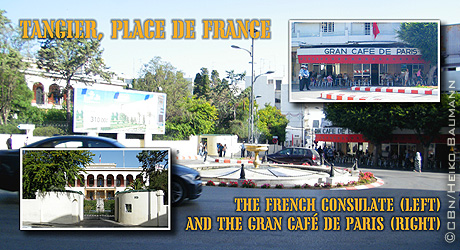
Upon consulting Google Earth, I could already see it: the building, the park, the driveway, even the fountain – it was all there: it’s the French consulate in Tangier. “Consulat de France” became “Hotel Île de France” – they didn’t even need to change the entire lettering. An image search on Google brought final confirmation: Bingo! Sometimes, it’s that easy. Standing in front of the Gran Café, all I had to do was turn around and click right away. Luckily, the French officials were a bit more cooperative than the Moroccan ones and didn’t see a problem in me taking some pictures, they just didn’t want to open the gate for me as the place was closed at that time of the day.
And that was the end of this rather short visit to Tangier. All that was left to do for me now was heading to the new port – a pleasant ride along the coast – thank my driver Hassan once again for his helpfulness, and then go and catch some more trains and boats and planes to bring me back home. And certainly not forget to take some pictures of yet another Bond location – Gibraltar – from the ferry.

